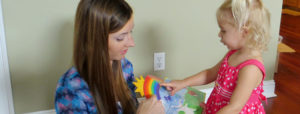 Specific Developmental expressive Language Disorder
Specific Developmental expressive Language Disorder
In this disorder, the ability to use expressive spoken language is markedly below the level appropriate for the child’s mental age. Language comprehension is within normal limits but there may be abnormalities in articulation. Language development varies considerably among normal children, but the absence of single words by 2 years of age, and of two-word phrases by 3 years of age signifies abnormality. Signs at later ages include restricted vocabulary, difficulties in selecting appropriate words, and immature grammatical usage. Nonverbal communication, if impaired, is not affected as severely as spoken language, and the child makes efforts to communicate. Disorders of behavior are often present.
Cluttering – some children speak rapidly and with an erratic rhythm such that the grouping of words does not reflect the grammatical structure of their speech. This abnormality, which is known as cluttering, is classified as an associated feature of expressive language disorder in DSM-IV but in ICD-I0 it is classified (with stammering) among other behavioral disorders of childhood.
Prevalence of expressive language disorder depends on the method of assessment; a rate of 3-5% of children has been proposed (American Psychiatric Association 1994a).
Prognosis of the disorder
It is reported that about half of the children meeting DSM-IV criteria develop normal speech by adult life, while the rest have long lasting difficulties (American Psychiatric Association
1994a). Prognosis is worse when the language disorder is severe, or there is a co-morbid condition, such as conduct disorder.
Treatment of Expressive Language Disorder
Treatment is mainly through special education. Psychiatrists are likely to be involved when there is a co-morbid disorder, and may need to advise the parents about the child’s rights for special education.
